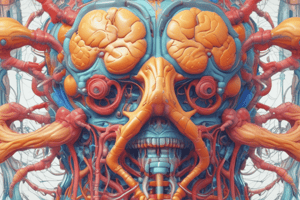Podcast
Questions and Answers
Which movement describes the rotation of the forearm so that the palm of the hand faces posteriorly?
Which movement describes the rotation of the forearm so that the palm of the hand faces posteriorly?
- Pronation (correct)
- Circumduction
- Supination
- Adduction
Which of the following movements is NOT a combination of other movements?
Which of the following movements is NOT a combination of other movements?
- Circumduction
- Rotation (correct)
- Extension
- Protraction
What is the main structure separating the thoracic cavity from the abdominal cavity?
What is the main structure separating the thoracic cavity from the abdominal cavity?
- Rib cage
- Diaphragm (correct)
- Mediastinum
- Abdominal muscles
Which of the following structures is NOT found in the mediastinum?
Which of the following structures is NOT found in the mediastinum?
What type of movement does the foot undergo when the soles face laterally?
What type of movement does the foot undergo when the soles face laterally?
Which movement describes the movement of a limb away from the midline of the body?
Which movement describes the movement of a limb away from the midline of the body?
Which of the following movements is NOT typically associated with the trunk?
Which of the following movements is NOT typically associated with the trunk?
Which joint type is capable of circumduction?
Which joint type is capable of circumduction?
Which cavity contains the stomach, intestines, liver, spleen, pancreas, and kidneys?
Which cavity contains the stomach, intestines, liver, spleen, pancreas, and kidneys?
Which of the following is NOT a characteristic of the pelvic cavity?
Which of the following is NOT a characteristic of the pelvic cavity?
Study Notes
Homeostasis
- "Homeostasis" translates to "unchanging," derived from “homeo” (same) and “stasis” (standing still).
- It refers to the maintenance of a stable internal environment despite external fluctuation.
- Variables such as temperature, volume, and chemical composition can change and affect homeostasis.
Homeostatic Mechanisms
- Mechanisms like sweating and shivering help regulate body temperature near an ideal set point.
- "Set Point" is the target normal value for maintaining variables.
- "Normal Values" represent acceptable ranges for achieving homeostasis.
Control Mechanisms
-
Negative Feedback Mechanism: Most common method to regulate body systems; it resists changes from the set point.
- Components:
- Receptor: Monitors specific variable values (e.g., blood pressure).
- Control Center: Establishes the set point and analyzes receptor information for response.
- Effector: Acts to correct deviations (e.g., controls heart rate).
- Components:
-
Positive Feedback Mechanism: Amplifies deviations from the set point; rare in healthy individuals.
- Examples include blood loss, childbirth through uterine contractions.
Anatomical Language
- Body Positions:
- Normal Anatomical Position: Standing erect, face forward, upper limbs at the sides with palms facing forward.
- Supine: Lying face up.
- Prone: Lying face down.
Directional Terms
- Right: Toward the body's right side.
- Left: Toward the body's left side.
- Inferior: Below.
- Superior: Above.
- Anterior: Toward the front.
- Posterior: Toward the back.
- Dorsal: Toward the back (same as posterior).
- Ventral: Toward the front (same as anterior).
- Proximal: Closer to a point of attachment.
- Distal: Farther from a point of attachment.
- Lateral: Away from the body’s midline.
- Medial: Toward the body’s midline.
- Superficial: On or toward the surface.
- Deep: Away from the surface.
Body Parts and Regions
- Cephalic: Head.
- Cervical: Neck.
- Thoracic: Chest.
- Abdominal: Abdomen.
- Pelvic: Pelvis.
- Upper and Lower Limb Regions: Various names for arms, legs, and associated joints.
Nine Regions of the Abdomen
- Umbilical Region: Surrounds the navel; contains parts of the intestines.
- Epigastric Region: Located above the umbilical region; includes organs like the pancreas and stomach.
- Hypogastric Region: Below the umbilical region; contains the bladder and parts of intestines.
- Iliac Regions: On either side of the hypogastric region; involve portions of intestines.
- Lumbar Regions: On either side of the umbilical region; contain portions of kidneys.
- Hypochondriac Regions: On either side of the epigastric region; encompass diaphragm and organ portions like the liver.
Planes of the Body
- Sagittal Plane: Divides body into left and right parts.
- Median Plane: A type of sagittal plane that creates equal halves.
- Transverse Plane: Divides body into upper (superior) and lower (inferior) parts.
- Frontal Plane: Divides body into anterior and posterior sections.
Movement Terms
- Flexion: Decreases angle between body parts.
- Extension: Increases angle between body parts.
- Abduction: Movement away from midline.
- Adduction: Movement toward midline.
- Rotation: Movement around an axis.
- Pronation: Palm faces downward.
- Supination: Palm faces upward.
- Circumduction: Circular movement combining flexion, extension, abduction, and adduction.
Body Cavities
- Thoracic Cavity: Enclosed by the rib cage; contains heart, lungs, and other organs.
- Abdominal Cavity: Houses stomach, intestines, liver, and other organs.
- Pelvic Cavity: Contains urinary bladder and reproductive organs.
Studying That Suits You
Use AI to generate personalized quizzes and flashcards to suit your learning preferences.
Related Documents
Description
Understand the concept of homeostasis, its importance, and the mechanisms that maintain a stable internal environment despite external fluctuations. Learn about set points and homeostatic mechanisms that regulate body conditions.




